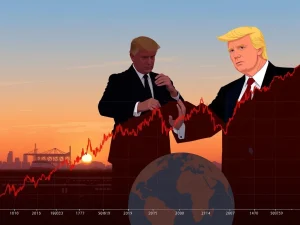Spot Bitcoin ETFs: Unpacking the Impact of Rising Inflation and Trump Tariffs

The cryptocurrency market recently experienced a notable shift. Spot Bitcoin and Ethereum ETFs recorded significant outflows on Friday, surprising many investors. This downturn coincided with the Federal Reserve’s release of key inflation data. The data indicated that price pressures are indeed creeping higher, largely influenced by President Donald Trump’s trade policies. This development has prompted a closer look at the interplay between macroeconomic factors and digital asset performance. Understanding these dynamics is crucial for anyone interested in the evolving crypto landscape.
Crypto Outflows Signal Market Sensitivity
Recent market data reveals a clear picture of investor sentiment. Both Spot Bitcoin and Ether ETFs saw substantial withdrawals, marking a pivot in their recent performance trends. SoSoValue data highlighted these shifts, providing concrete figures for market observers. This event underscores the sensitivity of digital asset markets to broader economic indicators and policy decisions. Investors often react quickly to new information, especially concerning inflation and potential changes in monetary policy.
Spot Bitcoin ETFs See Notable Withdrawals
On Friday, Spot Bitcoin ETFs registered their first daily loss since August 22. Investors withdrew a net total of $126.64 million from these funds. This reversal followed a period of generally positive inflows. Fidelity’s FBTC experienced the steepest single-day outflow, losing $66.2 million. ARK Invest and 21Shares’ ARKB also saw a significant net withdrawal of $72.07 million. Grayscale’s GBTC, a long-standing player, recorded $15.3 million in exits. Conversely, a few funds managed minor gains. BlackRock’s IBIT notably gained $24.63 million, while WisdomTree’s BTCW added $2.3 million. These figures illustrate a mixed but predominantly negative sentiment across the Bitcoin ETF landscape.
Ethereum ETFs Experience Sharp Reversal
Meanwhile, Ether (ETH) ETFs faced even larger withdrawals. They recorded a net outflow of $164.64 million on Friday. This marked a significant reversal after five consecutive days of inflows. Those previous inflows had collectively added over $1.5 billion to the asset class. The sudden shift for Ethereum ETFs indicates a broad market reaction. Total assets under management subsequently dropped to $28.58 billion for Ethereum and $139.95 billion for Bitcoin. Such rapid changes highlight the volatile nature of crypto investments, even within regulated ETF structures.
Understanding the Inflationary Pressure
The primary catalyst for these crypto outflows was the release of crucial economic data. The Federal Reserve’s preferred inflation gauge, the core Personal Consumption Expenditures (PCE) index, showed an annualized rise of 2.9% in July. This figure represents the highest level since February. The report matched economists’ forecasts, yet its implications for financial markets were immediate. Core PCE measures the prices of goods and services purchased by consumers, excluding volatile food and energy components. Therefore, it provides a clearer picture of underlying inflation trends. Higher inflation erodes purchasing power, potentially making riskier assets like cryptocurrencies less attractive to some investors.
How Trump Tariffs Fuel Price Hikes
Evidence suggests that former President Trump’s tariff regime significantly contributes to these rising core prices. CNBC reports indicate that these trade policies increase import costs. Trump’s White House imposed a baseline 10% tariff on all imports during his previous term. Furthermore, his administration targeted additional categories through reciprocal duties. These tariffs act as an additional tax on imported goods. Consequently, businesses often pass these increased costs onto consumers, leading to higher retail prices. This direct link between trade policy and domestic inflation creates a complex economic environment. While energy prices helped keep broader inflation in check, services jumped 3.6% year-over-year, indicating persistent price pressures in key sectors.
Market Reaction and Future Fed Actions
Despite the recent uptick in inflation, the market still largely anticipates a Federal Reserve rate cut at its next meeting. This expectation persists, particularly if upcoming labor market data shows further signs of weakness. Investors closely watch unemployment rates and job creation figures. Weak labor market data could provide the Fed with a rationale to ease monetary policy, even with inflation slightly elevated. However, the delicate balance between controlling inflation and supporting economic growth remains a challenge for policymakers. The future direction of interest rates will undoubtedly influence all asset classes, including digital currencies. Market participants are keenly observing every Fed announcement and economic report for clues.
The Resilience of Ethereum ETFs Amidst Corporate Demand
Before Friday’s outflows, Ethereum ETFs had demonstrated remarkable growth. Since their launch in July 2024, these spot ETFs gained steady traction. Net inflows surged by 44% in August, climbing from $9.5 billion to $13.7 billion. Analysts attribute this robust growth to a resurgence in institutional interest. After a period of underperformance relative to Bitcoin, Ethereum’s value proposition gained renewed recognition. Corporate treasury adoption of Ether is also accelerating. Companies now collectively hold 4.4 million ETH, valued at over $19 billion. This represents roughly 3.7% of Ethereum’s total supply, according to StrategicETHReserve data. Fabian Dori, Chief Investment Officer at Sygnum, highlighted this trend. He told Crypto News Insights, “After an extended period of underperformance relative to Bitcoin and a souring investor sentiment, Ethereum has recently experienced a significant revival in the recognition of both its adoption rate and value proposition.” This corporate confidence suggests a deeper, fundamental demand for Ether, potentially cushioning it against short-term market fluctuations.
Navigating Volatility in the Digital Asset Space
The recent crypto outflows from Spot Bitcoin and Ethereum ETFs underscore the dynamic nature of digital asset investments. Macroeconomic factors, such as rising inflation and government trade policies like Trump Tariffs, directly influence investor behavior. While Friday’s data showed significant withdrawals, it is crucial to view these movements within a broader context. The underlying demand for assets like Ethereum, especially from corporate treasuries, indicates long-term growth potential. Investors must remain vigilant, analyzing economic reports and policy shifts carefully. Diversification and a clear understanding of risk tolerance are more important than ever. The cryptocurrency market continues to evolve, presenting both challenges and opportunities for informed participants. Staying updated on these complex interactions will be key for successful navigation.







